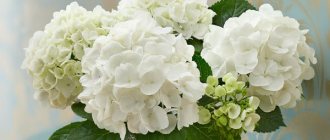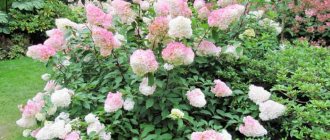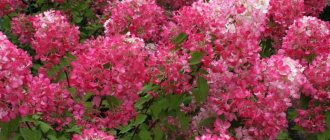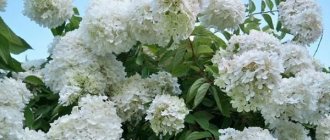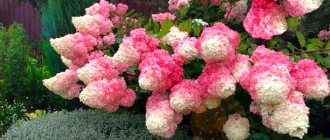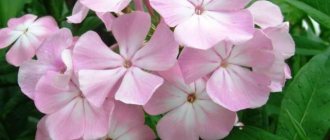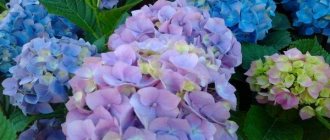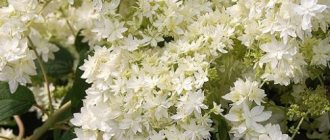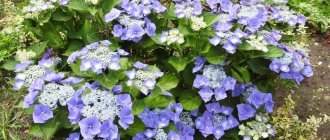Plants » Flowers
0
398
Article rating
Kira Stoletova
Among all the subspecies of Hydrangeaceae cultivated in Europe since the 14th century, red hydrangea is the most prominent representative of this family of flowers popular among gardeners. Blushing large “clouds” of inflorescences will decorate any flower garden. They look great both in composition and as a free-standing plant.
Red hydrangea
Description of culture
Hydrangea is a perennial shrub that has high decorative properties. A lush crown with bright large inflorescences during the flowering period looks impressive in flower beds and imitation barriers. Large leaf hydrangea or hydrangia is a very moisture-loving plant. The family includes several dozen varieties that differ from each other not only in decorative characteristics, but also in their care and sensitivity to weather conditions.
Frost-resistant varieties
The most popular frost-resistant varieties:
- Nikko blue. The shrub is quite low-growing. By the way, it can be grown both outdoors and on the windowsill of an apartment. Characterized by large blue inflorescences. The foliage has a bright green color. In open ground, the shrub can reach 1.5 meters in height. The amazing ability to change the color of flowers is a pleasant surprise for gardeners. Color saturation can vary from light blue to bright blue. This factor directly depends on the composition of the soil. The more acidic the soil, the richer the color.
- Miss Saori is a new generation large leaf hydrangea. This variety was bred several years ago and has already earned popularity among designers and amateur gardeners. In winter it can withstand temperatures down to -26 degrees. It is distinguished by a unique color: creamy flowers have a bright pink edging along the edge. The foliage has a bluish tint. Inflorescences cover almost the entire crown of the plant from June to August. The low-growing shrub is suitable for growing in pots.
- Masya. This is a remontant variety. Flowering takes place in two stages: from June to November with a short break in the middle of the cycle. The bush is quite large - up to 1.5 meters with spreading long shoots. As a rule, it requires a garter. A special feature of the variety is its abundant flowering. And the size of the inflorescence can reach 30 cm in diameter. The bright crimson flowers have a jagged edge, creating an imitation of lace. This variety is also dependent on the soil, so to obtain the necessary color saturation it is worth adjusting the acidity of the soil.
- Endlys Samme. A unique variety that blooms continuously from June to November. Hydrangea does not have outstanding decorative characteristics. The inflorescences are medium in size. The color may be blue or pink depending on the composition of the soil. But its ability to renew flowers every 5-6 weeks is impressive and attracts gardeners.
- Romance Pink is another representative of frost-resistant hydrangeas. It is distinguished by its rapid growth and original flower shape. However, the plant blooms for a short time. The flowering period lasts only a few weeks.
- Tugese is an amazing variety. It can be called a rainbow. In June, greenish inflorescences appear on the bush, which are replaced by a whole palette of colors, depending on weather conditions and soil composition. Probably no other plant can boast such a palette of colors.
Species requiring shelter
- Sybil. This is a small shrub up to 1 meter high. It has high decorative properties. Its inflorescences are gigantic in size. The flowers are painted pink-red and have a special glossy coating.
- Hot Red is a red hydrangea. The decorative properties probably end there. The inflorescences of the plant do not exceed 15 cm, and the lush bush is characterized by low growth.
- Renata Steiniger. Hydrangea of this variety has characteristic blue inflorescences. The shrub is tall, which allows it to be used as a flowering hedge.
Hydrangea is a shrub that grows naturally in Japan, southern China and some tropical islands. This fact explains the thermophilic nature of the culture. It is worth remembering that covering the plant should be done with special care.
Directions for breeding large-flowered hydrangeas
The shape of the inflorescences of large-leaved hydrangeas
First of all, the shape depends on which variety of hydrangea participated in the selection: changeable hydrangea (H. macrophylla var. mutabilis), with spherical and hemispherical lush inflorescences, or Japanese hydrangea (H. macrophylla var. japonica), with flat, graceful umbrella-shaped inflorescences.
The main breeding centers of large-leaved hydrangea are located in America, Holland and Japan.
Poisk store offer
Hydrangea large-leaved So Long RosieBuyHydrangea large-leaved So Long SunnyBuyHydrangea large-leaved AishaBuyHydrangea paniculata BoboBuyHydrangea paniculata White LightBuyHydrangea paniculata LamlightBuyHydrangea paniculata PolstarBuyHydrangea paniculata Samme SnowKu drinkHydrangea paniculata PhantomBuyHydrangea paniculata Midlate SammeBuyHydrangea paniculata Magical Sweet SammeBuyHydrangea paniculata Pastel GreenBuy
Features of large-leaved hydrangea flowers
The shape of the petals of sterile flowers in modern varietal hydrangeas is very diverse. They can be:
- wavy (Libertin);
- concave (Hopcorn);
- corrugated (Freepon);
- serrated and fine-toothed (Koria, Twist & Shout).
An interesting direction of selection is that produces flowers located along the edge of flat inflorescences on long stalks. Such inflorescences are found in the Fireworks or Shooting Stars series.
in the photo there is a large-leaved terry hydrangea
Variegation of leaves of large-leaved hydrangea
There are still few varieties of hydrangeas with variegated foliage. Among large-leaved hydrangeas, the most famous varieties are Variegata, Mariesii Variegata, whose green leaves have a white edge, Lemon Wave with yellow variegation, as well as Tricolor and Quadricolor, the foliage of which is covered with white and yellow spots and strokes of different sizes.
in the photo there is a variegated form of large-leaved hydrangea
The color range of large-leaved hydrangea varieties is very diverse - from pure white, pink to red and purple. There are also bicolor varieties or so-called chameleons, which gradually change color.
Landing rules
The time for planting hydrangeas in open ground is chosen according to the weather conditions of the region. If planting is carried out in cold northern regions, then it is better to carry out this procedure in the spring, then the seedling will have time to fully take root before the onset of winter.
In regions with a temperate climate, you can plant the plant both in spring (from mid-April to mid-May) and in autumn (from early September to mid-November)
When planting in autumn, it is important to have time to place the plant in the ground 3 weeks before frost, so that it has time to adapt and does not die when the temperature drops for the first time.
Growing conditions
Hydrangea is planted in well-lit or semi-shaded areas. For adequate plant development, the soil must be acidic and well-drained. Sandy loam or fertile soils are ideal
When choosing a site for planting, you should pay attention to the fact that the plant is not located in a flooded area during periods of snowmelt or rain, otherwise the root collar may be subject to fungal infection or rot.
The area for planting is prepared in the autumn. To do this, the area is cleared of remnants of vegetation, and the soil is dug up to a depth of 40 cm. For every 1 m², 5 kg of humus, 10 kg of peat and 10 kg of river sand are added. During the winter period, the soil will become looser and more moisture-permeable.
Important! You should not plant hydrangea near tall trees, otherwise large trees will absorb all the moisture when watering.
Instructions for planting hydrangeas in open ground:
- Dig a hole 40 cm deep and 30 cm wide.
- Mix the top fertile layer of soil with 10 kg of peat, 10 kg of sand, 5 kg of humus, 30 g of superphosphate.
- Place a layer of drainage (expanded clay, brick fragments, gravel) 5 cm high at the bottom of the hole.
- To the middle of the hole volume, the previously prepared substrate is added on top of the drainage base.
- The seedling is introduced into the hole and the rhizome is carefully spread over the mound of soil.
- Add soil to the top of the hole and compact it tightly.
- Water the plant with 5 liters of water and mulch with peat.
How to choose?
Before choosing a hydrangea, you need to decide on the location for its future planting. The varieties of this plant that are commercially available today can be characterized by different levels of frost resistance. This factor should be taken into account and the plant should be selected in accordance with the climatic characteristics of the area.
If there is little space on the site, then paniculate red hydrangea will be the best option, since most of its varieties do not exceed 100 centimeters in height.
It is also worth paying attention to the decorative qualities of the crop, because it is thanks to them that the plant will be able to decorate the territory.
When choosing a place to plant hydrangeas, you should not stop in the area near the path, as the fragile branches of the bush are prone to breaking off. Among the varieties of this representative of the flora, it is impossible to select the best one; each is beautiful in its own way. Therefore, when thinking about choosing a crop, you should be guided by personal preferences and characteristics of the plant.
Care
To ensure the most comfortable conditions for the growth and development of Schloss Wackerbart hydrangea, it is necessary to water it in time, feed it, loosen it and carry out sanitary and formative pruning. And you also need to remember to prepare the bush for winter.
Did you know? In Japan, the hydrangea flower is considered a symbol of sincerity of feelings and the manifestation of special cordiality.
How does hydrangea overwinter?
Around mid-August, when the last fertilizing is applied, the Schloss Wackerbart hydrangea begins to enter a dormant state. At this time, you need to stop watering it so that new flower buds begin to form. All dried inflorescences are cut off so that energy is not wasted on them.
Since this variety does not tolerate low temperatures and does not survive frosts below -18°C, it is necessary to take care of how the bushes will winter. To do this, they are hilled to a height of about 30 cm and the soil under them is covered with peat, sawdust, leaves or grass.
In northern regions with fairly severe winters, hydrangea needs more serious preparation for wintering. In the fall, before the cold weather sets in, it is necessary to cut off all the leaves, leaving only a few on top of each shoot. This will help the young branches become woody as soon as possible and prepare for the cold.
1 - inclined shoots, 2 - hilling, 3 - spruce branches, 4 - lutrasil, 5 - stone Branches that did not have an ovary can be shortened by half. After this, the plant is bent to the ground, near the roots it is covered with spruce branches, and where the tops are covered with conifers, peat is poured into the center of the bush. Then this entire structure is wrapped in roofing felt. Such protection, as a rule, can protect bushes even from severe frosts.
Watering and loosening
After planting, you need to water the hydrangea well so that its root system takes root in the new place and begins to grow. Subsequent watering in warmer months should be done once a week. 1-2 buckets of water for each bush will be enough. If it rains often, you can water less often.
The water must be settled, because hydrangea does not tolerate the presence of lime in the soil, which gets there with tap water. You can also use rain water, it has an excellent composition.
Loosening the soil around the plant must be done at least 2 times during the summer to better retain moisture and remove weeds that interfere with normal growth and development. You need to loosen it no deeper than 5–6 cm. For even better results, it is advisable to mulch the soil under the bushes with peat, sawdust or dry grass.
Top dressing
To improve the appearance of the plant and help it bloom long and profusely, it is necessary to add fertilizers containing the necessary nutrients to the soil. Wackerbart Castle hydrangea is fertilized 3 times per season.
Feeding is usually carried out according to the following scheme:
- in the spring, before growth begins, urea is added in the amount of 20 g per area of 1 m², as well as about 40 g of potassium sulfate;
- during the appearance of buds, the plant needs to be fertilized with potassium and phosphorus fertilizers, which are included in a special complex developed for flowering shrubs;
- in the middle and end of summer, two more feedings are carried out, the same as in early spring, to provide the hydrangea with a supply of necessary substances for growth and flowering next year.
The last time of the year, fertilizers are applied no later than mid-August, and then the plant does not need feeding, because it should gradually enter a dormant state.
Trimming
All varieties of large-leaved hydrangea require virtually no pruning. It is not recommended to remove old shoots, unlike other species, because in this case the plant will not bloom.
The main thing is not to forget to carry out sanitary pruning, during which you must remove all dry, diseased and damaged branches. And, of course, it is imperative to remove all inflorescences, but only after they have completely dried out.
Caring for red hydrangeas in the garden
Hydrangea is the garden and greenhouse star of modern Europeans. Many decades ago, when the heat-loving shrub was just imported from Japan, it had to be cherished and nurtured. Thanks to active breeding work, hydrangea has acclimatized to the cold, acquired new petal colors, and care has become easier. People have gained more experience in growing plants, on the basis of which they can change and achieve renewal of the color of inflorescences.
Note! It is no longer a sensation that the acidity of the soil and the color of the petals are directly related. For example, a blue hydrangea transplanted from acidic soil into an alkaline environment takes on a pink color.
For flowers grown at home, changing the color of flowers is easy and simple. In the water with which the plant is watered, it is enough to add a specially prepared mixture to acidify or neutralize acidity and you can get the desired effect. This property is used when creating landscape design
For example, a blue hydrangea, transplanted from acidic soil into an alkaline environment, takes on a pink color. For flowers grown at home, changing the color of flowers is easy and simple. In the water with which the plant is watered, it is enough to add a specially prepared mixture to acidify or neutralize acidity and you can get the desired effect. This property is used when creating landscape design.
Hydrangea grows in open ground
Watering mode
There are common features of all types of hydrangea. These are, first of all, requirements for regular watering. A shrub growing on sandy soil on the sunny side especially needs abundant irrigation. To conserve water at the roots, it is advisable to use mulch. But paniculate varieties are not afraid of dry weather.
Top dressing
The flora is rich. Hydrangea is both indoor and garden fauna. Inflorescence caps flaunting under the sun touch the soul of any person. In such a rich world of varieties and delicate colors, you can find your own flower that is close in spirit. But without real care, which consists of care and essential feeding, it is difficult for a plant to simply survive.
The growth and development of the green crown requires a large amount of nitrogen fertilizers. Urea plus potassium sulfate gives the desired mixture, which is dissolved in water in a certain ratio. For a 10 liter bucket of water, just add 2 tbsp. spoons of the mixture (one of each component). 5 liters of mineral fertilizer are applied to each bush.
Note! The shrub needs organic matter. For this purpose, slurry is used, diluted with water in a ratio of 1:10.
Each bush is fed separately. A weak solution of potassium permanganate gives the stems strength and flexibility.
At each stage of development, hydrangea should receive different types of feeding. The formation of buds and the moment the leaves bloom are different phases. On the eve of flowering, phosphorus and potassium are most needed. These elements are found in superphosphate, of which 1 tbsp is taken. spoon and dissolve in 10 liters of water. The green crown is sprayed with the same solution. During the flowering period, treatment is carried out three times.
Hydrangea is characterized by a variety of varieties
Features of care during the flowering period
June is the time of formation of flower buds, the number of which depends on fertilizing. During this period, it is advisable to apply mineral fertilizers in the form of nitrophoska and agricola (1 tablespoon of each ingredient per 10 liters of water). In July, hydrangea needs green fertilizer in the form of nettle infusion. Add 1 bucket for each bush and an additional 1 bucket of clean water.
For active long flowering in mid-summer, it is useful to apply a complex fertilizer called kemira flower with a dosage of 1 tbsp. spoon into a bucket of 10 liters of water. By the beginning of August, nitrogen fertilizing is stopped so that the plants are not burdened with green mass and overwinter safely. Mineral fertilizing should be alternated with organic watering (bird droppings, slurry).
Note! Hydrangea is responsive to atypical fermented milk products. Take 1 part of kefir, curdled milk or whey, dilute it with 3 parts of water and apply it to the plantings.
It is practiced to add soaked sour bread into the soil in a mushy form. During the flowering period, fertilizing is done every 2 weeks.
Panicle varieties of hydrangea do not require special care
Features of care during the rest period
After vigorous flowering, a long period of dormancy begins. At this time, cleaning of the area and gradual preparation for wintering begins.
Changing the color of inflorescences
The amazing property of large-leaved hydrangea to change color depending on the acidity of the earth is widely known. Laboratory studies have shown that the main factor influencing this process is the concentration of aluminum compounds in the inflorescences. The more it is, the darker the color – blue. A slight presence of aluminum contributes to a less saturated tone - blue, and the absence - pink.
The acid-base balance of the soil affects the presence of aluminum in it. In acidic soil (Ph<5.5), this chemical element is well absorbed by the roots of the plant. A decrease in acidity (neutral soil) and a transition to alkaline characteristics worsens the degree of digestibility of aluminum and, accordingly, leads to a change in color to lighter, blue and pink tones.
By adjusting the soil balance using various additives, you can achieve the desired color scheme. It should be noted that not all varieties of large-leaved hydrangea can change color.
Obtaining blue shades (increasing soil acidity) is facilitated by:
- ½ cup of colloidal sulfur per 1m2 area (sprinkle and water);
- adding citric acid to water for irrigation;
- fertilizer “Blue hydrangea” (according to instructions);
- aluminum phosphate (15 g/1 l of water);
- aluminum sulfate (1 tablespoon/1 liter of water);
- aluminum or iron alum (10 pcs./2 l of water).
To acquire pink-red tones (decrease in acidity and increase in soil alkalinity), it is recommended:
- 1.5 cups of dolomite flour or crushed chalk per 1m2 area (sprinkle and water);
- 1 tbsp. a spoonful of slaked lime per 3.5 liters of water;
- 1 teaspoon of copper sulfate per 7 liters of water.
It is best to apply the dry products listed above (by sprinkling method) within 3 months - March, April and May. However, this is not a quick process and it takes time to get results. Using liquid additives is a faster option to change the color of hydrangeas.
Carefully! Do not allow solutions to come into contact with foliage.
The relationship between the color of the inflorescences and the acidity of the soil is as follows:
- blue, cyan and lilac (and their shades) – pH <5.5;
- white and cream, other very light shades - pH (5.7-6.0);
- pink and red (and their shades) - pH (6.1-6.3).
Attention! The maximum soil acidity level for growing large-leaved hydrangea is 6.4. Subsequently, liming of the soil occurs, which is extremely harmful for the plant.
Caring for red hydrangeas in the garden
Growing garden flowering large leaf hydrangeas can be difficult. Many novice gardeners do not take into account the main feature of this species of Hydrangea - the formation of buds occurs on flowering shoots growing on the tops of stems grown last year. Therefore, planting, pruning bushes, and covering Hydrangea macrophylla have certain rules that differ from the same rules for other types of hydrangeas.
Place of cultivation
Choose a shaded place, protected from the wind and located on the eastern or northern side of the site. This choice will help in the spring to slow down the development of flower buds to prevent them from freezing in the event of spring frosts. In the southern and western areas, the soil and air warm up faster than in the eastern and northern areas, so the buds begin to wake up earlier and die from the return cold.
Soil composition
Hydrangeas are grown in fertile clay soils with a low acidity level.
Growing hydrangea in a pot
To plant a young hydrangea bush, prepare a substrate from humus, leaf soil, and bottom peat (1:1:1). Add 1.5 tbsp to the planting hole. l. urea, 2 tbsp. l. potassium, 4 tbsp. l. superphosphate.
Important! Do not add chalk, lime, or wood ash under hydrangea bushes.
Feeding
Hydrangea macrophylla bushes planted in prepared fertile soil are not fed for 2-3 years. A sign that the soil is depleted will be insufficient growth of stem mass, a decrease in the size of the buds, and a lighter shade of the leaves.
The first fertilizing is carried out in early spring on moist soil after the ground has warmed up. A complex is used, which includes nitrogen (urea), superphosphate, potassium (2:1:0.5). Organic matter is added to mineral fertilizers - an aqueous solution of rotted manure (1 liter per 10 liters of water). After 2 weeks, fertilizing with organic fertilizers can be repeated. Use an infusion of bird droppings - 0.5 liters per 10 liters of water.
During budding, use a mixture of 3 tbsp. l. superphosphate and 2 tbsp. l. potassium sulfate dissolved in 10 l. water. Hydrangea has a long flowering period, so this fertilizer composition is used one more time.
Watering
Hydrangeas, with their abundant blooms, require large amounts of water. But moisture should not spread over the surface of the trunk circle of the bush and immediately evaporate from the heat and wind. Therefore, when watering, the following rules should be observed:
- Watering is carried out early in the morning or in the evening after sunset.
- Use settled tap or spring water heated to ambient temperature.
- Watering should be rare but plentiful - at least 10-20 liters per bush, depending on the size of the plant.
- If necessary, the water is acidified. Dissolve 0.5 g of citric acid or 2 tbsp in 10 liters of water. table vinegar.
In hot weather, the frequency of watering is increased; in rainy weather, they focus on the condition of the soil in the root zone.
Additional Information. New types of large-leaved hydrangeas have been created that bloom twice per season. The description of the flower indicates that the plant first lays buds on last year’s branches, then on young shoots
Planting a plant in open ground
Choosing a place and time of landing
Large-leaved hydrangea is a finicky crop, so its location in a summer cottage is of great importance for normal growth.
The basic requirements for the landing site are as follows:
- Good lighting. Hydrangia is predominantly light-loving. She needs at least 6 hours of sunlight a day, but it is advisable that this time be distributed between the morning and evening hours. On a hot afternoon (from 12 to 15 hours), the plant needs to be shaded to avoid drying out the flowers and overheating the roots.
- Protection from wind and drafts. It is better to plant an ornamental crop in the southern part of the site, so that on one side it is partially covered by a house wall, a fence or taller shrubs.
- Deep groundwater (at least 1.5 m) and the absence of lowlands. If soil water is close, drainage must be installed in the hole.
- Remoteness from trees and shrubs with a shallow root system, since in the future they will compete for moisture and nutrients.
Large-leaved hydrangeas should be planted in the spring, when the ground has completely warmed up and the threat of frost has passed. For most regions of the European part of the Russian Federation, this is the beginning of May. In the south, the planting date may be earlier, as well as in early autumn.
Soil preparation
Soil plays a very important role for the proper growth and flowering of all types of hydrangeas. And in relation to large-leaved varieties, the importance of the soil increases more, since the color of the inflorescences also depends on its acidity.
To grow the crop, it is necessary to use loose, well-watered and breathable soil, enriched with organic matter.
The most important point when planting hydrangia is determining the acidity of the soil.
Depending on the “native” color of the variety, as well as the possibility and desire to change it, the acid-base balance of the soil is adjusted. Strongly acidic soil is neutralized by adding dolomite flour or chalk (2 kg/5m2), and alkaline soil is acidified with peat (1 kg/4m2) or colloidal sulfur (1/2 cup/m2). It is advisable to carry out all preparatory operations in the fall. If they are transferred to the spring, 3 weeks before planting.
The hole for planting is made 2 times larger than the volume of the root along with a lump of earth with it (on average about 40 cm). Soil is selected from it, and a drainage of gravel, expanded clay or broken bricks with a height of about 8-10 cm is laid on the bottom. Drainage is mandatory if groundwater is close to the groundwater. Next, the space is filled with a substance from leaf and turf soil, humus and river sand in the proportion: 2:1:2:1, respectively.
Excessively dry soil is moistened using hydrogel (30 ml/hole).
In addition to the soil mixture, fertilizers are added to each hole:
- superphosphate - 70 g;
- potassium sulfate - 25 g;
- urea - 20 g.
The distance between bushes, depending on their type (compact or spreading), is left on average 1-1.5 m.
When filling the soil, it is important that the upper part of the plant's root system is at ground level (transparent). Then the soil is compacted, watered and mulched (with peat chips, sawdust, bark or pine needles), which helps retain moisture and prevents the growth of weeds.
Propagation of large-leaved hydrangea Bouquet Rose
Hydrangea in the garden can be propagated generatively (by seeds) and vegetatively (by layering, dividing the bush, cuttings). Each gardener chooses which method to use. The easiest option is to propagate by cuttings.
Propagation by cuttings
Green stalk - part of the shoot with leaves and buds. This method is the simplest and most accessible.
Planting material is prepared in mid-July. Cuttings taken early in the morning from the lower branches of young plants, without signs of diseases and pests, will take root well.
Preparing a hydrangea cutting
Rooting is carried out as follows:
- After cutting, the shoots must be placed in water.
- Remove the top with the bud (if any) from the shoot.
- Divide the remaining shoot into segments with 2-3 pairs of leaves.
- Cut off the lower leaves from each cutting and shorten the upper ones by a third.
- Place the cuttings in a solution of a root formation stimulator for 2 hours.
- Rooting is carried out in a moistened mixture of sand and peat (1:2).
- Cover the rooted cuttings with a jar.
- It is necessary to water the cuttings 2-3 times a week.
- After a month, remove the jars.
If the cuttings took root on the site, then during the cold months they need to be insulated with covering material on the arches, and on top with spruce branches. The grown bushes are planted in a permanent place.
Growing from seeds
Seed propagation of hydrangeas is a labor-intensive and painstaking process; it does not always ensure accurate transmission of varietal characteristics.
Growing from seeds is carried out according to the following algorithm:
- In autumn, seeds are sown in a container on the surface of the soil; do not sprinkle soil on top. After 4-5 weeks, shoots will appear.
- Seedlings are picked 2 times, selecting only the strongest.
- After picking, fertilize with a specialized fertilizer for seedlings.
- Young hydrangeas are planted in open ground 1.5-2 years after sowing.
Caring for hydrangea during the growing season
During the growing season, hydrangea requires careful care. This promotes flowering. Mandatory work includes: fertilizing, watering, protection from pests.
Feeding hydrangea
In the spring. The first feeding of hydrangea is carried out in the spring, back in March. It is needed for the formation of green mass in the plant. It is recommended to add potassium sulfate and urea. The bushes are watered with a diluted mixture (5 l/bush), or slurry with water (1:10).
The second feeding is carried out when the buds begin to form. To get many, many flowers, you need to prepare an aqueous solution with superphosphate or any other fertilizer containing potassium and phosphorus.
Three times in the spring you need to spray and water with a weak solution of potassium permanganate. This will help the bush become strong and flexible.
In summer. In the first month of summer, the bushes are treated with a mixture of Agricola and Nitrophoska. This will increase the number of buds.
In July, a diluted infusion of nettle is poured under each bush. This organic fertilizer helps to increase flowering time. You can also use complex fertilizers (Kemira for flowers).
In August, it is better to exclude complex fertilizers, since most of them contain nitrogen, and the plant does not need it during this period. You can water the bushes with slurry or a solution of bird droppings. The plant also responds well to the application of non-standard fertilizing (whey or kefir with water 1:3)
In autumn. Potassium and phosphorus are two elements the plant needs before hibernation. It is necessary to dilute potassium sulfate and superphosphate in water (1 tablespoon/10 l). One bush will require approximately 7 liters. It is useful to spread organic matter near the bushes: peat, compost. This will protect the roots of the plant from freezing and feed the hydrangea with nutrients.
Watering hydrangea
Watering hydrangea bushes should be regular. The plant does not tolerate drought well. For irrigation, it is better to use settled warm water. It is necessary to ensure that the top layer in the tree trunk circle is always slightly damp.
Prevention and treatment of hydrangea
Chlorosis. Sometimes hydrangea leaves begin to turn yellow, while the leaf veins remain dark. The buds are deformed. The reason lies in metabolic disorders; the plant is sorely lacking iron. Most often, chlorosis occurs on plants that grow in one place for a long time. To get rid of the scourge, you need to feed the hydrangea with iron-containing preparations: Agricol, Antichlorosis, Ferovit.
Gray rot. In rainy weather, fungal diseases, such as gray rot, grow well. It damages the tissues, which become watery. Spraying with Fundazol will help. But all damaged areas must be removed and burned.
Powdery mildew. If yellow spots appear on the leaves, it is necessary to spray with copper-containing preparations. You can use fungicides (Fitosporin, Skor), they also help cope with powdery mildew.
Ring spot. The leaves begin to wrinkle and the plant fades. This viral disease has not yet been fully studied, so there is no drug treatment. Infected bushes must be removed and burned. The cause of the disease can be insects or infected planting material.
Spider mite. If the leaves begin to fall off, drying out, and there is cobwebs on the inside of the leaves, then it is necessary to spray the plant with Actellik.
To prevent the development of diseases and protect hydrangea from pests, it is necessary to focus on preventive measures.
- In early spring and autumn, the bushes must be treated with Bordeaux mixture.
- All planting material, especially if it is purchased from an unknown gardener, must be treated with copper sulfate.
- It is recommended to add insecticidal preparations to the soil during planting.
- Regular weeding of the garden is required to prevent pests and infections from multiplying on the weeds. It is better to burn plant remains.
Reproduction
You can propagate the shrub yourself. The result is planting material for group planting. Currently, hydrangea is rarely propagated by seeds.
Reproduction methods:
- Cuttings. In the period from mid-spring to early summer (April-June), you need to select shoots that are no more than a year old and at least 15 cm long. Then cut cuttings from them at right angles. Next, remove all the foliage from the base of the cutting and treat it with a growth-stimulating drug, for example, Kornevin. Then plant in containers filled with a mixture of earth, sand and turf soil (1:1:1). Store in greenhouse conditions until rooting.
After the formation of young shoots, remove them from the greenhouse and provide partial shade. Further care includes watering twice a week. You can plant it in open ground next spring.
- Dividing the bush. In spring or autumn, you need to dig up the bush and divide it into several parts so that each fragment has a developed bud. Then plant it in the ground in a permanent place.
- By layering. To propagate a bush in this way, you need to select a young shoot, no older than one year, and bend its middle to the ground and secure it. The top, about 20 cm long, should remain free. The plant will take root completely after a year. Then it needs to be separated from the mother bush and transplanted to a permanent place.
Diseases and pests
When grown in open ground, flowers are susceptible to the following dangers:
| Problem | Solution | Prevention |
| Gray rot | Caused by the fungus Botrytis cinerea. Destroy the affected areas or the plants themselves. Treat with systemic fungicides (Topsin, Fundazol) or a solution of copper sulfate and laundry soap. | Avoid overmoistening, do not thicken plantings, provide ventilation. Remove debris and cut (dead) parts of the plant in a timely manner. |
| Powdery mildew | The fungus undermines the immune system. Destroy affected parts. Organic (low-toxic) fungicides containing potassium bicarbonate, sulfur, lime, and neem tree oil (margosa) are effective. | Do not put stems, leaves, or fruits affected by powdery mildew into compost. |
| Rust | A fungal disease that is easily identified by rust-colored spots. Destroy the affected parts or the plant itself. Does not like sulfur and preparations based on it. It dies from fungicides such as Strobi, Polyram, Cumulus, and Abiga-Pik. | In spring, treat with colloidal sulfur and Bordeaux mixture. |
| Spots on leaves | Caused by fungi and bacteria. Remove diseased leaves. Spray with fungicides. | Water moderately. |
| Slugs | Shellfish eat the leaves. Easy to assemble using trap containers filled with beer or mash (a combination of yeast, molasses, corn and wheat flour). Avoid lime, ash, ground eggshells, coffee grounds, and pine needles. They can be sprinkled around the bush. | Remove debris, boards, branches, bricks from the area, under which slugs hide. Mow weeds. |
Features of care during the rest period
Hydrangea bushes should not go into winter with dried out roots. If there is no rain in the fall, 2 weeks before frost, the plants are watered abundantly with the addition of superphosphate. In rainy weather, fertilizer granules are scattered on the surface of the soil under the bushes. Plants that grew outdoors in large pots or barrels are lowered into the basement with an air temperature of +5 ° C to + 10 ° C. Periodically moisten the soil in the containers.
Selective pruning of large-leaved hydrangeas is carried out in early spring after the coverings are removed. Remove broken and excess stems.
When growing large-leaved hydrangeas, many inexperienced gardeners make mistakes: they completely prune the bushes or untimely remove their cover after wintering. But they learn from mistakes. If the hydrangea root does not die in frost, then even if not immediately, even in the second or third year of cultivation, this beautiful plant will still bloom near the house or in a container.
Preparing for winter
Hydrangea paniculata white, red, pink - the best winter-hardy varieties
Hydrangea macrophylla should not be pruned after flowering. Some flower growers do not even remove faded inflorescences so as not to damage the tops of the stems, but pruning of the leaves is mandatory. You can avoid pruning hydrangeas only in those regions where plants are not protected from the cold in winter. In the northern regions it is impossible to do without removing the inflorescences.
Sheltering a hydrangea bush for the winter
A frame is installed over the hydrangea bush, the stems are carefully tied into several bunches, covered with coniferous spruce branches, and covered with agrofibre and plastic film.
Description of the variety
Large-leaved hydrangea (Hydrangea macrophylla) belongs to a species of plants of the genus Hydrangea, family Hydrangea. This species has a large number of different varieties, one of which is Fiery Beauty.
The culture grows as a shrub that can reach up to 2 m in height. It is used to decorate landscape areas by planting in compositions with other decorative flowers and shrubs or placed as a tapeworm.
Appearance
The crown of the plant has a spreading shape. It reaches 2 m in diameter. The leaf blades are large, smooth, ovoid in shape, with a pointed end. Their color varies from light green to dark green.
The flowers are collected in large spherical inflorescences. They can reach up to 20 cm in diameter. A single flower has 4 petals tightly adjacent to each other. Its diameter is 3–4 cm. The petals are painted bright red with a pink tint.
Characteristics
The shrub variety Fiery Beauty begins to bloom in early July. With proper care, flowering time lasts until mid-November. The plant is heat-loving; regions with a temperate or warm southern climate are excellent for its cultivation. The frost resistance of the shrub is characterized as high - up to -18°C. The plant requires increased attention to hydration.
Large-leaved hydrangea seedlings. Mail delivery! Buy in the online store.
An unseen treasure.
The first red hydrangea, blooming in spring on last year's shoots, in summer - on current growth. The inflorescences are lush, rare shades of brilliant red, becoming rich purple over time. The bush is compact, picturesque, with pinkish, burgundy-colored shoots and bright green leaves of compressed texture, permeated with pronounced venation. The price is for 1 seedling of large-leaved hydrangea. This planting material is mailed out in the SPRING.
On this page of our online store you can order hydrangea seedlings by large-leaf mail with cash on delivery. Seedlings are sent without prepayment. Payment for ordered seedlings occurs at the Russian Post office upon receipt.
Large-leaved hydrangea (Hydrangea macrophylla) is as spectacular and divinely beautiful as all hydrangeas. Its flowers are collected in large corymbose or spherical inflorescences with a diameter of 20-30 cm. Compared to other species, it is more delicate and heat-loving, so treat it with care - it will reward you a hundredfold! Flower buds are laid in the fall and are easily affected by early frosts; you can protect them from this scourge with a double layer of lutrasil or greenhouse film. For the winter it requires shelter; the frost resistance threshold without shelter is -17-23 °C.
Origin and appearance of hydrangea Bouquet Rose
East and southeast Asia and North America are considered the homeland of large-leaved hydrangeas.
Hydrangea Bouquet Rose is a deciduous shrub with a spherical crown up to 1.3 m high. Its annual growth is 20 cm. The bush has opposite leaf arrangement, the leaves are large, ovate, rough, and their color does not change in autumn.
Blooming hydrangea variety Bouquet Rose
Trimming macrophiles.
Pruning large-leaved hydrangea has its own characteristics, because... If all the rules are not followed, then you may not only not wait for lush flowering, but also ruin the bush.
Sanitary pruning of large-leaved hydrangea is done according to general rules: weak, dead, old (over 4 years old) and thickening shoots are removed.
Faded inflorescences in the summer (and then only until the end of June) can be cut off with part of the stem and leaves, but in the fall only its cap is removed. This is done so that the growing buds have time to ripen and set a peduncle and the decorative effect of the plant is not affected. If you cut the stem in the fall, the buds will not have time to ripen and will not flourish the next year.
There is one more feature of pruning new remontant varieties of hydrangea. In the summer (until the end of June, this is IMPORTANT, because the bud will have time to ripen and set a flower) very briefly, young non-flowering shoots are cut off to one side bud. You can trim no more than 1/3 of all shoots of the bush, so as not to deprive it of nutrition and not weaken it with excessive pruning. It will be much easier to preserve such a low shoot and a bud on it.
